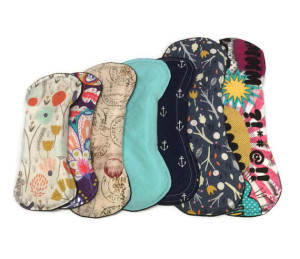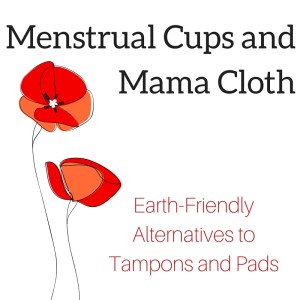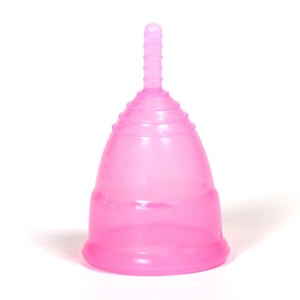So this is my first post for Dallas Moms Blog and as I brainstormed all the fun topics I wanted to write about on this new platform, I somehow talked myself into making my first post all about periods. Yep, what better way to introduce myself to 16,000 new friends than to share with you all how I deal with my monthly flow. So hi, I’m Rachel and I use a menstrual cup. There you go, we’re practically BFFs now. And now that we’re best friends, we can pretend this conversation is totally not awkward.
Oh, what’s a menstrual cup? Basically, it’s a reusable alternative to tampons. And it’s not the only alternative either. Did you realize there are so many more options than the feminine care aisle at the supermarket carries? Menstrual cups, cloth pads, period panties, there are even cloth tampons…and they are all better for you and for the Earth. All those plastic wrappers and applicators can really add up over a lifetime.
Let’s all pretend we’re back in the fifth grade and we’re learning for the first time what to do when your period arrives, but instead of only presenting the two main-stream options we learned about the first time we had this little talk, we’re learning all the options. And this time our vulnerable little minds aren’t being swayed by big corporations with their snazzy little goodie bags. Sorry, no goodie bags this time. I know, try not to be too let down.
Menstrual Cups
Shaped kind of like a silicone tulip, menstrual cups are designed to create a suction seal near your cervix to catch your flow. They simply need to be emptied, rinsed, and re-inserted every 4 to 12 hours, depending on your flow that day. At the end of the week, you just boil it for a few minutes before you store it until next month. That one cup can be reused for at least a year, more likely two.
Most women find that their cramps are less severe or even non-existent when using a menstrual cup. They are more cost-effective than tampons, they have virtually no waste other than the box they come in, so they are one of the greenest options available, there are no chemicals or risk of Toxic Shock Syndrome, you can swim, run, shower, bathe, do yoga in them. Honestly, it’s easy to forget you’re even on your period when wearing one.
Girlfriend to girlfriend, there is a learning curve to the cups and there’s a little bit of a gross out factor, but after a couple of cycles, it becomes incredibly easy and a little less gross. I recommend wearing a panty liner (see green options for those below) for the first cycle or two as a back up and on your heaviest cycle day. Don’t worry though, you can find tons of helpful tips and videos on YouTube to get you through the learning curve.
Some of the most popular cups are the Diva Cup, Luna Cup, Lunette Cup and the Blossom Menstrual Cup. This thorough comparison chart by Put A Cup in It is really helpful. Actually that whole site is a great cup resource. You can find menstrual cups online at places like Amazon or KellysCloset or at The Nappy Shoppe in Plano and even at your local CVS. Prices range from $15 to $40 per cup.

Reusable Cloth Options
And not to be left out, pad wearers and postpartum mamas have green alternatives too. Just like there are fabulous cloth diaper options, there are a ton of cloth menstrual pad options on Etsy and Amazon. They are, dare I say it, actually adorable. The cloth pads above are from LoveYourReusables. Super cute, right?
Cloth pads (or commonly called Mama Cloth) are typically made from a bottom layer of PUL (a flexible waterproof material) or fleece, an absorbent layer like bamboo, and then a wicking fabric layer, like microfleece. They snap around your underwear and work just like disposable pads. The downside is that they can shift more than regular pads with sticky backing if you’re very active, but they are softer and more comfortable than disposable pads and liners and you can wash and reuse them. There are also panty liner and heavy flow options specifically for postpartum mamas. There are even cloth tampons. Options ladies, so many options! Prices range from $3-10 per pad.
Period Panties
One of the newest options on the market are period panties. You’ve probably seen the highly marketed new lacy Thinx, Period Panties for the Modern Woman. They look just like normal panties, but have a thin absorbent layer built-in under a breathable anti-bacterial wicking top layer. Thinx is the first brand that comes to mind, but a search for period panties on Amazon yields several options.
The obvious upside to period panties is comfort and ease. They look and feel just like a nice pretty pair of undies with no wings or flaps or pad imprints to declare to the world, or probably just your husband, I’m on my period! They are also great for those of us mamas who can no longer sneeze without crossing our legs and saying a prayer. The downside is that if you choose to use them without a cup on a normal flow day, you’ll have to change your panties a few times, which, at around $30 a pair, could get expensive, not to mention slightly awkward in a public restroom setting.
To clean them, just like cloth pads, run them through a rinse cycle and then wash them on cold with no fabric softener. You can even add other laundry to the load after the rinse cycle.
Thanks for becoming my BFF and for not making any immature jokes during this totally not-awkward presentation about your menstrual options now that you’re officially an environmentally conscious young woman? Can someone please get the lights?
















Very intriguing!
Where can I find reusable panty liners in Dallas area?